Integrated shrub management in semi-arid woodlands of eastern Australia: ground and aerial application of defoliant to shrubs regenerating after disturbance
J. C. Noble A G , W. J. Müller B , N. D. MacLeod C , Z. Bodulovic D , P. Jones E and J. T. Wood B FA CSIRO Sustainable Ecosystems, GPO Box 284, Canberra, ACT 2601, Australia.
B CSIRO Mathematical and Information Sciences, GPO Box 664, Canberra, ACT 2601, Australia.
C CSIRO Sustainable Ecosystems, Queensland Bioscience Precinct, 306 Carmody Road, St Lucia, Qld 4069, Australia.
D Agtech Pty Ltd, 16 Waite Place, Farrer, ACT 2607, Australia.
E Department of Primary Industries, Locked Mail Bag 6, Emerald, Qld 4720, Australia.
F Current address: Statistical Consulting Unit of the Graduate School, Australian National University, Canberra, ACT 0200, Australia.
G Corresponding author. Email: jim.noble@csiro.au
The Rangeland Journal 27(2) 117-134 https://doi.org/10.1071/RJ05010
Submitted: 30 August 2004 Accepted: 24 August 2005 Published: 21 November 2005
Abstract
This paper describes experiments undertaken at several sites in semi-arid woodlands of eastern Australia to determine if chemicals applied either on the ground or from the air reduce the density of shrubs regenerating after disturbance. Ground-spraying of Roundup® in the autumn was more effective than spring application in defoliating shrubs, especially 2-year-old coppice growth. Spraying of Roundup with a hand-held boom at 0.5 up to 2.5 kg glyphosate/ha identified rates to be used for boom spraying. Aerial spraying experiments were then undertaken across several sites and involved several target species. The location of sufficiently large areas where shrub regeneration was of an optimum age (i.e. about 2–3 years) proved to be extremely difficult due to prevailing drought conditions precluding the use of prescribed fire as a preliminary treatment. Nonetheless in one experiment, young (1-year-old) regrowth of firebush (Senna pleurocarpa) exhibited increased sensitivity to Roundup with significant shoot mortality recorded after it had been applied at 0.5 kg glyphosate/ha. Aerial spraying based on an ultra-low volume application of 10 L/ha further enhanced cost-effectiveness on this occasion. Economic analyses structured around 20-year partial budgeting and determination of net present value (NPV) suggested a profitable return could be expected where treatment was based on Roundup applied at this threshold rate 2 years after a prescribed fire, especially when the rehabilitation costs were spread over an entire paddock that had been only partially sprayed. Finally, operational aspects involving aerial spraying in these semi-arid woodlands are also discussed.
Additional keywords: adjuvants, arboricides, coppice age, economics, glyphosate.
Introduction
‘Vegetation thickening’ occurs in many ecosystems throughout the world (Gifford and Howden 2001) and is pronounced in semi-arid woodlands following anthropogenic changes to disturbance/recovery regimes (Harrington et al. 1979; Hodgkinson 1979; Walker and Gillison 1981). Gifford and Howden (2001) estimated that 60% of Australian forests and woodlands are recovering from clearing or partial clearing while a substantial component of the savanna woodlands in the remaining 40% has been partially cleared by ring-barking to increase herbage production.
The rate of post-disturbance recovery or ‘thickening’ varies according to the form and intensity of human intervention. This, in turn, is mediated by factors relating to both economic and environmental sustainability (Noble 1997; MacLeod and Noble 2001). Consequently, management systems have been developed to stabilise the recovery phase so that shrubs do not suppress herbage (e.g. Batianoff and Burrows 1973; Hodgkinson 1993; Booth et al. 1996a , 1996b ).
While prescribed fire has been advocated as the most cost-effective option on the basis of conventional economic criteria, this approach is severely limited by the unreliable nature of herbage fuel which is driven primarily by antecedent rainfall (Hodgkinson and Harrington 1985; Noble et al. 1986; MacLeod and Johnston 1990). Single treatments give only temporary respite. More effective strategies include integration of 2 or more treatments applied sequentially at critical stages in the shrub regeneration cycle (Noble et al. 2001; Scifres 1986). Small-plot experiments using artificial fuel have demonstrated that 2 or more fires applied annually can significantly reduce shrub populations, especially when follow-up fires are applied in the autumn (Hodgkinson 1998; Noble 2001).
The use of other control options has been severely constrained by high costs (MacLeod and Johnston 1990; MacLeod 1993; MacLeod et al. 1993; Noble et al. 1997; MacLeod and Noble 2001) (Table 1). Since prescribed fires cannot be applied annually under practical conditions, it was postulated that foliar sprays applied at lower than normal concentrations might be used to mimic annual experimental fires (Noble et al. 1993). Subsequent screening experiments provided strong evidence that some chemicals, especially glyphosate, when spot-sprayed at high volume (about 100 L/ha) were capable of scorching 90–100% of young foliage (i.e. up to 2 seasons’ regrowth) when applied in the autumn at dilute concentrations (Noble et al. 2001).
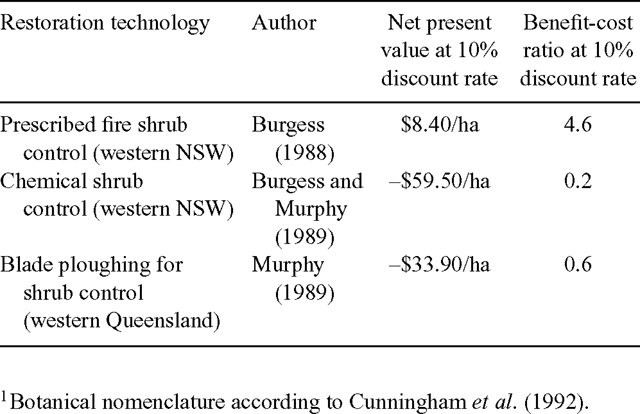
|
Further studies to refine broad-scale application using either ground or aerial spraying could not be undertaken without first determining suitable application rates based on the quantity of active ingredient applied per hectare. Given suitable weather conditions, aerial spraying enables quick, effective treatment of discrete areas or landscape units within large paddocks. Young (1–2 years old) suckers of brigalow (Acacia harpophylla 1 ) were successfully sprayed from the air in Queensland, sucker density declining by 70–88% after 2,4,5-T was applied in the late summer/autumn period (Johnson and Back 1977a , 1977b ). Nonetheless, aerial spraying of herbicides using relatively high volumes (e.g. 30–40 L/ha) may be inefficient in a rangeland context with flying time limited by the need for the aircraft to land and reload at frequent intervals.
Ultra-low volume (ULV) spraying (i.e. 5–10 L/ha) using Micronairs (spinning cage atomisers) or constant pressure (CP) nozzles mounted beneath an aircraft raises both efficiency and cost-effectiveness because larger areas can be treated per load. Much less water is required, an important consideration in semi-arid areas where water of sufficient quality (ideally rainwater) is often limiting. Small droplet size generated by ULV spraying, especially using Micronairs, can result in significant dispersal thereby increasing the likelihood of an optimum droplet density of around 20 droplets/cm2 leaf area (Mathews 1979
The technical and economic limitations of single treatment approaches have inevitably led to considering how the best features of individual methods might be effectively combined to provide an economic means of control (e.g. Scifres et al. 1983, 1985; Scifres 1987; Noble and Walker 2005). This paper describes results obtained from experiments aimed at determining the effectiveness of a selected chemical (glyphosate) applied both on the ground and from the air, with and without adjuvants. Data provided by economic models employed to define a specific chemical cost threshold above which it became uneconomic to undertake aerial defoliation are also discussed.
Methods and materials
In all the following experiments, plants were identified individually using numbered aluminium tags inserted into the ground. In the ground spraying experiments only, coloured flagging was also tied to each tag with colour combinations varying according to a pre-arranged code to ensure the correct spray treatment was applied to each specified shrub. The same formulation of Roundup®, i.e. 360 g/L glyphosate, was used in all the following experiments. As in previous experiments (Noble et al. 2001), unless otherwise stated, leaf effect (i.e. leaf scorching) was rated on an eleven-point scale ranging from 0 (no effect) up to 10 (100% scorching of coppice foliage) at intervals of 1–3 months over the following 12 months. Plants were defined as dead when they were given a leaf effect score of 10 in the last two assessments. All statistical analyses were performed using GenStat (VSN International Ltd, Hemel Hempstead, UK).
Ground spraying experiments
Experiments were conducted over a 4-year period (1993–96) involving preliminary fire or mechanical treatments followed by ground spraying treatments (spot or boom spraying). Spot spraying was undertaken using either a Cooper Pegler® backpack sprayer (only at ‘Baykool’) or more commonly, a propane-powered gas-gun (Ag-murf®). Boom spray treatments were applied using a hand-held, propane-powered boom spray (2 m wide), with groundspeeds of personnel applying the treatments calibrated beforehand to provide a constant volume of 72 L/ha.
‘Baykool’ (1993–96). Three replicate blocks, each containing six plots averaging 37 × 2 m in size, were established on ‘Baykool’ Station west of Augathella, Queensland (Fig. 1) in a vegetation community chained ten years earlier and dominated by budda, locally known as false sandalwood (Eremophila mitchellii) 2 . Five plots in each block, excluding randomly located ‘controls’, were subsequently re-chained in October 1993. Immediately before re-chaining, shrub canopy cover in each plot was estimated by measuring the cross-diameters of every shrub canopy situated within a 2 m wide belt transect running up the middle of each plot. Ten or more individual plants were then identified within each belt transect for future survival monitoring. Shrubs were classed as live if there were any green leaves or green stems visible, and survival expressed as number of live plants per plot.
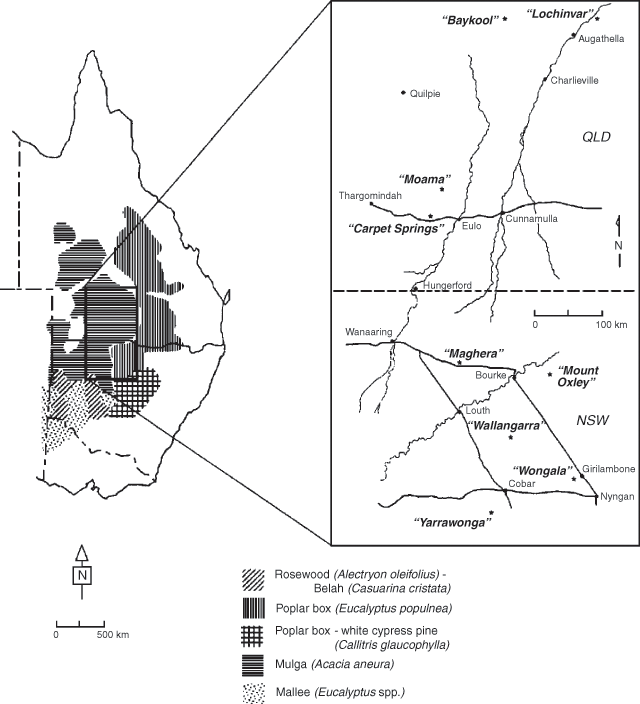
|
A second measurement of canopy cover and shrub survival was undertaken in April 1994 immediately before all the plots were burnt. Some shrubs were individually burnt by drip torch to overcome fuel discontinuity. A third measurement was then carried out in June 1995 followed by spot spraying of Roundup at four concentrations and at high volume (240 mL/m2). Consequently 6 treatments were established:
-
control;
-
chaining + fire; and
-
(iii–vi) chaining + fire + Roundup @ 1:80, 1:40, 1:20 and 1:10.
Final canopy cover and shrub survival (number of live plants per plot) were determined in June 1996. The significance of differences between treatments was examined for canopy cover and shrub survival at each measurement time by ANOVA. A loge transformation was applied to canopy cover data. The analyses for canopy cover and number of live plants per plot during 1994 to 1996 were repeated with the 1993 values of these variables used as covariates.
‘Yarrawonga’ (1993–95). Another experiment was undertaken on ‘Yarrawonga’ Station south of Cobar, New South Wales (Fig. 1) to determine whether the response to chemical treatment changed gradually over time during the spring/summer period, and whether there was any seasonal interaction with coppice age. Four blocks were established in a near-monospecific community of turpentine (Eremophila sturtii), and each block was divided into 5 plots. Five spraying treatments were randomly allocated to the 5 plots within each block. In four of the treatments, Roundup was applied either by spot spraying at four concentrations (1:80, 1:40, 1:20 and 1:10) or boom spraying at 4 rates (1.0, 1.5, 2.0 and 2.5 kg glyphosate/ha). In the fifth treatment, a mixture of Roundup @ 1:80 (gas gun) or 1 kg acid equivalent (a.e.)/ha (boom spray) and Brushoff® @ 3 g metasulfuron methyl/ha was applied.
Within each plot, 20 randomly selected shrubs were individually decapitated at their base by chainsaw in October 1993, December 1993 and February 1994. For each decapitation time and for each of the 2 spraying methods, 2 coppicing shrubs were sprayed at 4 specific times, namely 2, 4, 6 and 12 months after decapitation. The remaining four shrubs were controls – decapitated but not sprayed.
Individual shrub heights were recorded when plants were initially tagged so that leaf, stem and total biomass, all calculated using allometric relationships developed by Harrington (1979), could be used as covariate data if necessary. Five assessments of leaf effect were made in August 1994, October 1994, February 1995, June 1995 and October 1995. Shrubs sprayed 6 months after decapitation were not rated at the first assessment and shrubs sprayed 12 months after decapitation were not rated at the first, second and third assessments due to spraying not being completed for all decapitation times at those dates.
As the treatment combinations with ratings available for analysis varied over the five assessments, separate ANOVAs were performed on leaf effect scores for each assessment. These ANOVAs effectively had a split plot structure, with spraying rates as main plots and timing of decapitation and timing of spraying as split plot factors randomised within the main plots.
‘Maghera’, ‘Wallangarra’ and ‘Wongala’ (1993–94). Further experiments were established in April 1993 at ‘Maghera’ west of Bourke, ‘Wallangarra’ north of Cobar and ‘Wongala’ west of Girilambone, New South Wales (Fig. 1) in areas where mature budda or turpentine had been chained 13–14 months earlier. At ‘Wongala’ and ‘Wallangarra’, individual shrubs of budda were selected following chaining in February and March 1992, respectively. At both sites, most plants had been flattened by chaining but not completely uprooted. Two distinct age classes of foliage were distinguished, i.e. mature canopy foliage and juvenile ‘coppice’ foliage, the latter epicormic shoots emerging along the upper surface of the prostrate trunk. At ‘Maghera’, a monospecific stand of turpentine growing on a dune site had been chained in March 1992.
The biomass of each turpentine coppice was estimated independently by double sampling (Andrew et al. 1979) for later covariance analysis if required. In the case of regenerating budda at both ‘Wongala’ and ‘Wallangarra’, the size of each tagged plant was recorded as the horizontal length while biomass of mature and juvenile foliage was estimated separately by double sampling.
Within each of four replicate main blocks, 12 plots (about 15 × 15 m) were established with buffers of at least 5 m separating adjoining plots. Each of 12 treatments (described below) was randomly allocated to one plot in each block. Six plants were tagged in each plot at ‘Wallangarra’ while three plants were tagged in each plot at ‘Maghera’ and ‘Wongala’. A hand-held boom spray was used to apply Roundup over a range of five acid equivalent concentrations (0.18, 0.25, 0.5, 1, and 2 kg glyphosate/ha) to these plants. Control plants were also randomly selected within each plot. Six additional treatments included the use of selected adjuvants [Pulse® (0.1% v/v), Surge® (1% v/v) and Goal CT® (0.018 kg a.e./ha)] to determine whether their addition, either singly or in combination, would enhance the activity of Roundup applied at low rates. Spraying was carried out at all three sites in late April 1993 during mild temperature (25–30°C) and relative humidity (31–48%) conditions with occasional light winds gusting up to 10 km/h.
The following 12 treatments were established at all three sites:
-
control,
-
(ii-vi) Roundup only @ 0.18, 0.25, 0.50, 1.00 and 2.00 kg glyphosate/ha,
-
(vii-viii) Roundup @ 0.18 and 0.25 kg glyphosate/ha + Pulse @ 0.1% v/v,
-
(ix-x) Roundup @ 0.18 and 0.25 kg glyphosate/ha + Goal CT @ 0.018 kg a.e./ha, and
-
(xi-xii) Roundup @ 0.18 and 0.25 kg glyphosate/ha + Goal CT @ 0.018 kg a.e./ha + Surge @ 1.0% v/v.
Separate ANOVAs using loge initial biomass as a covariate were applied to the leaf effect scores at each assessment at each site.
‘Lochinvar’ (1993–96). A further experiment was established on ‘Lochinvar’ Station about 90 km north-east of Augathella in western Queensland (Fig. 1) where a stand of firebush (Senna pleurocarpa) had been stick-raked in September 1993.
The following 6 treatments were randomly allocated to individual plots averaging 24 × 2.6 m in size (separated by 5 m buffers) within 3 replicate blocks:
-
control,
-
stick-raked only, and
-
(iii-vi) stick-raked + Roundup @ 1.0, 1.5, 2.0 and 2.5 kg glyphosate/ha.
Roundup was applied in April 1994 at varying rates using the hand-held boom spray described earlier. Spray treatments were applied shortly after dawn to minimise wind drift and evaporation. Because of the height of the regenerating firebush (about 2 m), treatments had to be applied by an operator, supported by safety straps, leaning out from the tray of a 4-wheel drive utility while driving down one side of the plot and back along the other. A hand-throttle fitted in the vehicle maintained a previously calibrated groundspeed ensuring treatments were applied at a constant volume of 72 L/ha.
Estimates of both canopy cover and stem density (number of stems per plot) were obtained immediately before stick-raking all plots (except controls) in September 1993. Cover estimates and counts of live stems were made within a belt transect (2 m wide) running up the middle of each plot. Further canopy cover and stem density estimates were obtained in April 1994, immediately before spraying, and again in May 1995 and June 1996. The significance of differences between treatments was examined for canopy cover and stem density at each measurement by ANOVA. All data were loge transformed. In addition, the analyses for canopy cover and stem density from 1994 to 1996 were repeated with the 1993 values of these variables used as a covariate.
Aerial spraying experiments
Distribution patterns of spray droplets and potential swathe widths were initially assessed at Bourke (NSW) airport in 1994 using water-sensitive cards placed at regular spacings on the ground. The aircraft, an Air Tractor AT-802A, flew at different heights while applying contrasting volumes and was later used in all aerial spraying experiments.
For each experiment, three swathes were sprayed in each plot with each plot identified by a numbered tag and individually coloured flagging tape as a cross check. Flight lines for each swathe were marked by a person at both ends of the plot holding up a bright orange flag. Constant radio contact was maintained between markers, researchers and pilot during spraying.
‘Mount Oxley’ (1994–95). The first aerial spraying experiment was undertaken in May 1994 on ‘Mount Oxley’ Station, about 90 km east of Bourke (Fig. 1) where an area had been cleared by bulldozing three years earlier. Three rate treatments (1, 1.5 and 2 kg glyphosate/ha) were established at both ultra-low volume (ULV) and low volume (LV) (10 and 30 L/ha, respectively). ULV treatments were applied first, starting with the lowest glyphosate concentrations. The aircraft was fitted with CP nozzles set to provide droplets of 200–250 µm with treatments applied from a height of about 10–15 m due to large trees scattered throughout the experimental site. Water-sensitive cards placed on the top of target shrubs confirmed this setting provided an average density of 25 droplets/cm2.
This preliminary experiment was designed as a randomised block with 6 volume × rate treatments plus a control, all replicated twice. This design was applied both to the cleared area and to an adjacent uncleared area. Adjacent plots in the two areas received the same treatments, so that the aircraft could continue on from the cleared experimental area to the uncleared area and vice versa. Individual plots comprised 3 swathes, each of 25 m width, for the ULV treatments and 22 m width for LV treatments. Buffers between plots were 30 or 20 m, the larger buffers being used for the ULV treatments to minimise drift. Plot widths therefore varied from 70 m for LV treatments to 100 m for ULV treatments and were at least 150 m long.
Prior to aerial spraying, five Eremophila coppices in each cleared plot were identified using aluminium tags. In each uncleared plot ten shrubs and non-target woody species were tagged, with varying numbers of each species in each plot. The shrubs were either budda or turpentine, while the trees included leopardwood (Flindersia maculosa), wilga (Geijera parviflora), whitewood (Atalaya hemiglauca), ironwood (Acacia excelsa), supplejack (Ventilago viminalis) and poplar box (Eucalyptus populnea).
ANOVAs were initially performed on leaf effect in the cleared plots for each of the four sampling times. Because the leaf effect scores were predominantly clustered near either 0 or 10, only the binary response of dead or live was analysed. This binary response was analysed using a generalized linear mixed model with binomial errors and logit link (Schall 1991) to test the significance of the random effects, i.e. block and plot within block. As both were not significant and as no deaths occurred for control plants, the binary response for plants in sprayed plots was then analysed using a generalised linear model with binomial errors and logit link (Dobson 1990).
No formal statistical analyses were performed on leaf effect in the uncleared plots, as average numbers of plants for each species were less than two per plot, and unevenly spread across the experimental area. Proportions of plants that died were calculated from leaf effect scores at the final sampling in a manner similar to that used for the cleared plots.
‘Carpet Springs’ (1995–96). Because of the constraints imposed on replication by area limitations, as well as the presence of tall trees during the pilot study at ‘Mount Oxley’, a further aerial spraying trial was established in June 1995 on ‘Carpet Springs’ Station, about 60 km west of Eulo, Queensland (Fig. 1). Here a large area of gidgee (Acacia cambagei) had been chained 5 years earlier thereby eliminating most tall obstructions as well as providing more than sufficient area for both additional treatments and replication. Furthermore, a wider range of shrub species including budda (Eremophila mitchellii), turpentine (E. sturtii), emubush (E. longifolia) and tar bush (E. glabra) was available.
Ten treatment combinations were used. Roundup was applied from the air in May 1995 at 2 volumes (10 and 20 L/ha) at each of three rates (1, 1.5 and 2.5 kg a.e./ha). Three further treatments involved the application of Brushoff (600 g metasulfuron methyl/L) on its own, Brushoff + Roundup at 1 kg glyphosate/ha, and Brushoff + Roundup at 1.5 kg glyphosate/ha, all applied at 20 L/ha. These treatments were included since both materials were known to be compatible with one such formulation now marketed as Trounce®. The tenth treatment was a control (unsprayed).
Fifteen plots 200 m long and 108 m wide were marked out in each of 2 adjacent paddocks, and 3 replicates of the 10 treatments were applied to these plots so that each treatment occurred once or twice in each paddock. Treated plots were sprayed in May 1995 in 3 swathes each 36 m wide from a height of 3–4 m when fine conditions and light winds prevailed. Drift onto adjoining plots was minimised by 100 m wide buffers.
Due to the large area involved in this experiment, and the consequent non-random species distributions characteristic of natural communities, it was impossible to obtain representative samples of all target species within each individual plot. Accordingly, 20 shrubs were selected in each plot comprising ten each of the 2 most abundant shrub species of the four species listed above. After tagging, shrub height was also recorded for later covariance analysis.
Since patterns of occurrence of the four species over the 30 plots varied considerably, leaf effect scores for each species were analysed separately. Residual maximum likelihood estimation (Patterson and Thompson 1971) was used to determine whether there were significant differences between paddocks and between plots within paddocks after adjusting for treatment differences. No overall paddock differences or substantial between-plot variations within treatments were detected. Accordingly, analyses of variance were performed using shrub height as a covariate to examine differences between plots based on between-shrub variation.
‘Lochinvar’ (1995–96). An additional aerial spraying experiment was established on ‘Lochinvar’ in two adjacent paddocks where the ground vegetation was dominated by firebush (Senna pleurocarpa) communities of contrasting age. One paddock contained 10-year-old firebush that had been chained and burnt in 1974 before being re-chained in 1985. The adjoining paddock contained 1-year-old firebush that had also been chained originally in 1974, again in 1989 and then burnt in October 1994.
Because of area limitations, four treatments were randomised within 2 replicate blocks in each firebush age class. Roundup was applied at three rates (0.5, 1 and 2 kg glyphosate/ha) and at an ultra-low volume of 10 L/ha, with the fourth treatment an unsprayed control. Plots were 50 × 200 m with 30 m buffers separating adjacent plots. Aerial spraying was undertaken in 2 × 25 m swathes in each plot at a height of 3–4 m 2 days after the ‘Carpet Springs’ experiment in May 1995. While heavy overcast conditions prevailed for most of the spraying period with some light rain falling 2 hours after spraying had been completed, only a trace was recorded in a nearby pluviometer.
Ten firebush ‘plants’ (i.e. individual stems) were randomly tagged in each plot. Preliminary ANOVAs of leaf effect at each assessment resulted in distributions of residuals with smaller values near the extreme ratings of 0 and 10, meaning that a logit-transformation should be applied. The transformation used was loge [(score+0.25)/(10.25-score)]. The binary response (dead/live) was also analysed using a generalized linear model with binomial errors and logit link.
‘Moama’ (1996–97). A final aerial spraying experiment was conducted in mid-July, 1996 on ‘Moama’ Station, about 90 km north-west of Eulo in western Queensland (Fig. 1), where a large area of gidgee (Acacia cambagei) woodland had been chained in October 1989. A randomised block design was established with 3 blocks and 10 plots per block. Plots were 75 m wide and 200 m long and were separated by 95 m buffers, while larger buffers of 200 m separated adjoining blocks. Roundup was applied at three rates (1, 1.5 and 2.5 kg glyphosate/ha) at each of three volumes (10, 20 and 40 L/ha), with the tenth plot in each block being a control. Spray treatments were applied in 3 × 25 m swathes from a height of 3–4 m under ideal conditions with some high cloud and a light northerly breeze present. Spraying commenced at 1100 hours and was completed by 1250 hours.
Although the vegetation was dominated by budda (Eremophila mitchellii), other shrub species were also present including green turkey-bush (E. gilesii), tar bush (E. glabra), emubush (E. longifolia) and ellangowan poison bush (Myoporum deserti). Twenty five shrubs were randomly selected and tagged within the central 50 m of each plot, 5 plants from the ‘highly sensitive’ species ellangowan poison bush, ten from the ‘moderately sensitive’ species emubush, tar bush or green turkey-bush (numbers of each of these three species varied with abundance on each plot), and 10 from the ‘least sensitive’ species, budda.
Since patterns of occurrence of the three ‘moderately sensitive’ species varied considerably over the 30 plots and there were distinct differences in overall levels of responses of the 5 species, leaf effect scores for each species were analysed separately. Differences between control and treated and the effects of rate and volume were examined by ANOVAs on leaf effects for ellangowan poison bush and budda (equal numbers in each plot) and by residual maximum likelihood estimation for the other species (highly unequal numbers in each plot). Shrub height was also included as a covariate in the analyses for all 5 species.
Economic analysis
Assuming success is reached in identifying technically feasible fire/chemical defoliation strategies, an important consideration for potential adoption on a commercial scale would be their economic feasibility. A guide to the potential scope for integrated shrub control in the period during which the trials described in this paper were being planned, was provided by a benefit-cost analysis based on an adaptation of two previous studies that examined the prospective values of prescribed fire (Burgess 1988) and chemical treatments (Burgess and Murphy 1989) as separate options for shrub control.
Heuristic data derived from rangeland research and extension workers were used to construct a 20-year partial budget to examine the NPV of the net benefit stream that may accrue from the application of a serial autumn fire treatment (years 0 and 5) supported by chemical defoliation (year 1) to a heavily shrub-encroached 4000 ha paddock. This paddock was assumed to be grazed by a self-replacing flock of Merino sheep typical of those managed in shrubby country in the study region. The prices and cost data used in the original analysis (Table 2) covered the 1990–1991 financial year and were based on published data available at the time (Burgess and Murphy 1989). Because the analysis was specifically designed to identify the approximate threshold cost per hectare for any chemical treatment beyond which such treatment would no longer be profitable, the chemical agents and their price and application rates were not specified. That is, the NPV of the cumulative net benefit stream, exclusive of the chemical cost, will identify the threshold chemical cost below which the fire-chemical treatment will provide an economic rate of return greater than the discount rate used to derive the NPV. As some time has passed since the original cost-benefit analysis was conducted, an updated analysis has been completed using current economic values (April–May 2005) (Table 2).
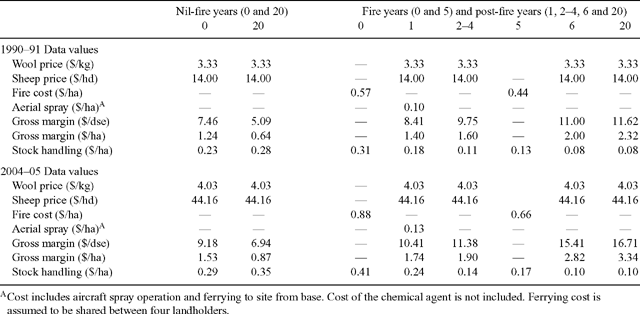
|
Results
Ground spraying experiments
‘Baykool’ (1993–96). Initial canopy cover was highly significant as a covariate in the analyses of canopy cover on all subsequent samplings. Accordingly, treatment comparisons were based on analyses of covariance of log-transformed cover (Table 3). Chaining of budda, prescribed fire 8 months later and a chemical defoliation 10 months later using Roundup, killed nearly all treated shrubs despite a wide variation in chemical concentration (Fig. 2). There was a significant additive effect of chemical defoliation (P < 0.05); prescribed fire on its own did not induce as much shrub mortality. The initial chaining killed 10% of the original budda stand and subsequent prescribed fire and chemical spraying together killed a further 94% of remaining shrubs.
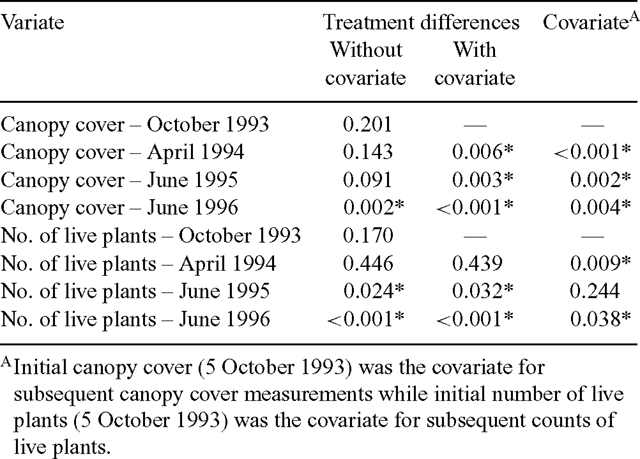
|
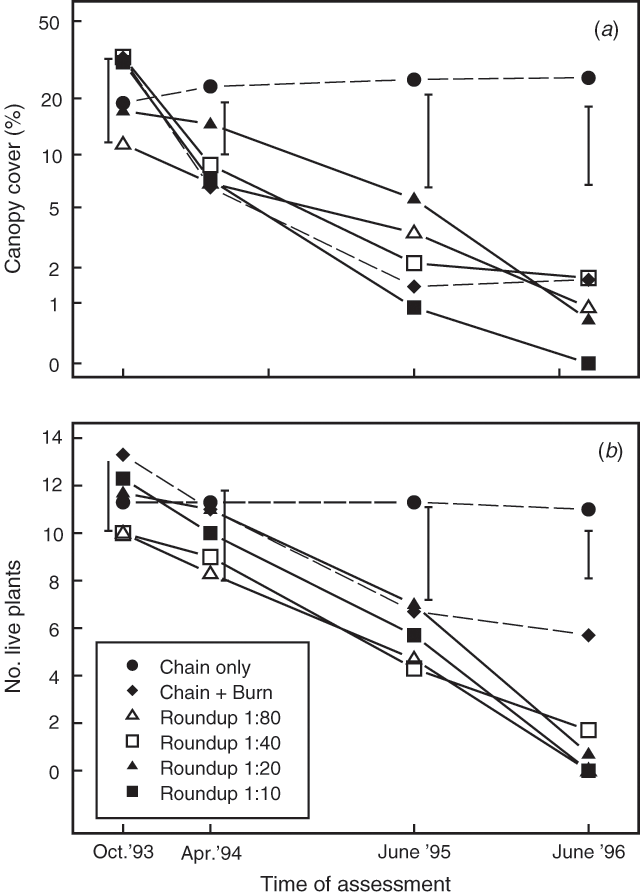
|
‘Yarrawonga’ (1993–95). Highest leaf effect occurred on 4-month-old coppice sprayed in the autumn while lowest values were obtained for winter spraying (Table 4).
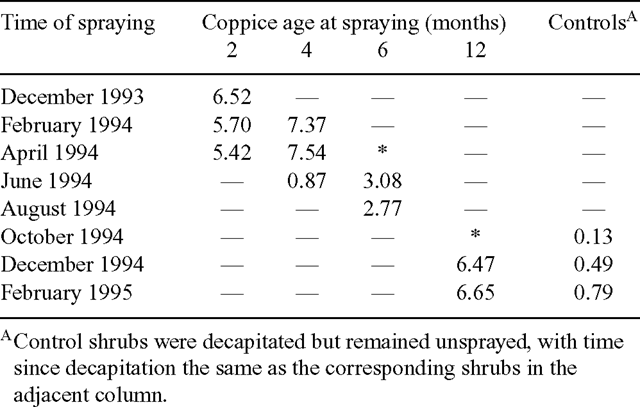
|
The 3 times of decapitation and 4 times until spraying resulted in varying numbers of combinations of these treatments being available at different assessments. For ease of analysis, these factors were combined into a single ‘timing’ factor that had up to ten levels; data were not collected for shrubs decapitated in October 1993 and sprayed at 6 or 12 months of age.
Differences between control and sprayed plants were highly significant, as were the main effects for rate, timing, and method (Table 5). The rate × timing interaction was significant for three of the five assessments. Apart from the second assessment, there were no significant interactions involving method of application, i.e. spot v. boom spraying. This meant that trends over time for mean responses across the 2 application methods were broadly similar to the trends for boom spray only, the only notable difference between methods being higher leaf effect scores recorded at low concentrations after spot spraying.
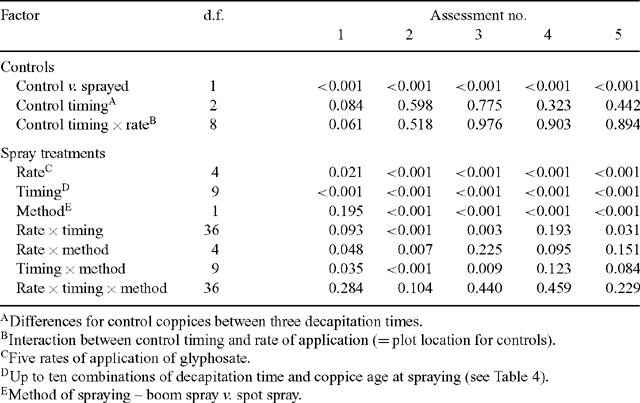
|
Predicted leaf effects for four contrasting treatments applied as a boom spray (1 kg glyphosate/ha, 1 kg glyphosate + 3 g Brushoff/ha, 1.5 kg glyphosate/ha and 2.5 kg glyphosate/ha) clearly illustrate a positive response to increasing application rate of Roundup (Fig. 3). One general exception to this was the treatment where turpentine was decapitated in February 1994 and then sprayed 4 months later in June. Generally the most rapid decline in leaf effect was over the spring/summer period between October 1994 and February 1995.
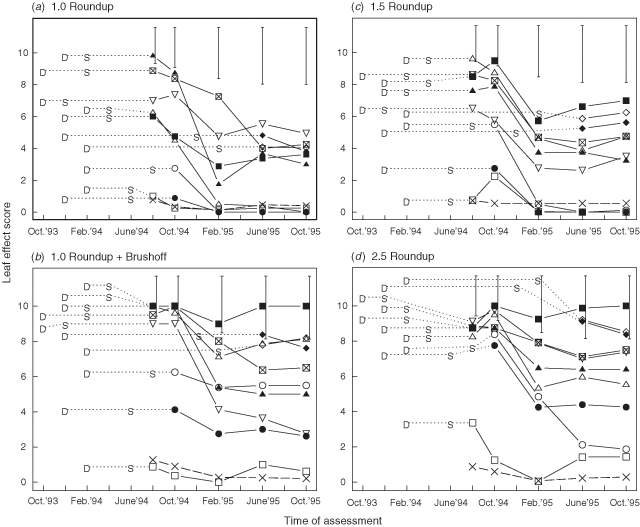
|
While leaf effect scores generally increased as the concentration of Roundup increased, apart from treatments applied in winter where scores were consistently low, there was clear evidence of a synergistic response to the Roundup/ Brushoff treatment (Fig. 4). Here Roundup applied at the lowest rate (1.0 kg glyphosate/ha), when mixed with Brushoff, produced leaf effect scores equivalent to those obtained from treatments where Roundup only was applied at the highest rate of 2.5 kg glyphosate/ha.
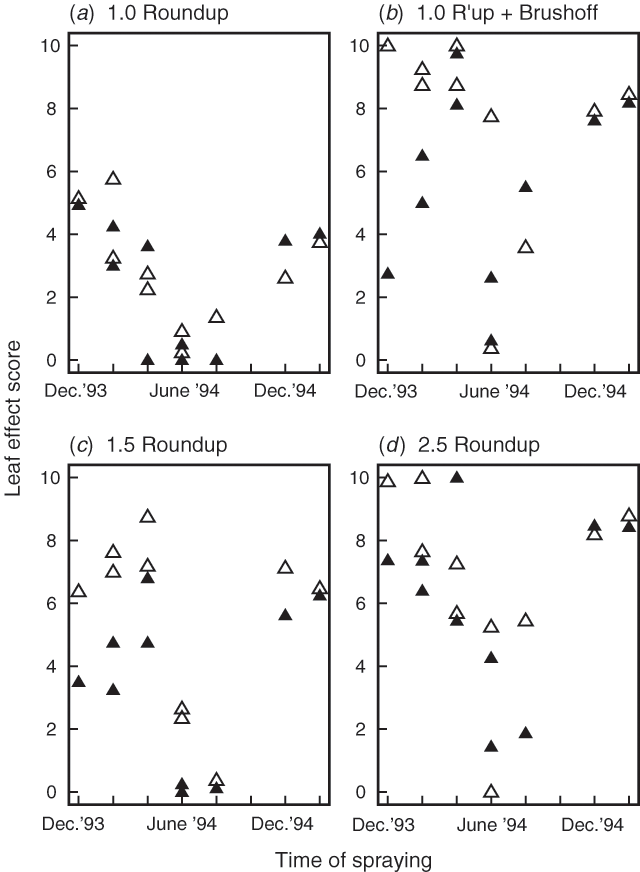
|
‘Maghera’, ‘Wallangarra’ and ‘Wongala’ (1993–1994). At ‘Maghera’, the highest treatment rate of Roundup (2 kg a.e./ha) applied to turpentine coppice had a significantly (P < 0.05) higher leaf effect than any other treatment. The addition of any of the adjuvants, however, failed to provide any significant increase in activity of Roundup applied at the lowest rate (Fig. 5a ).
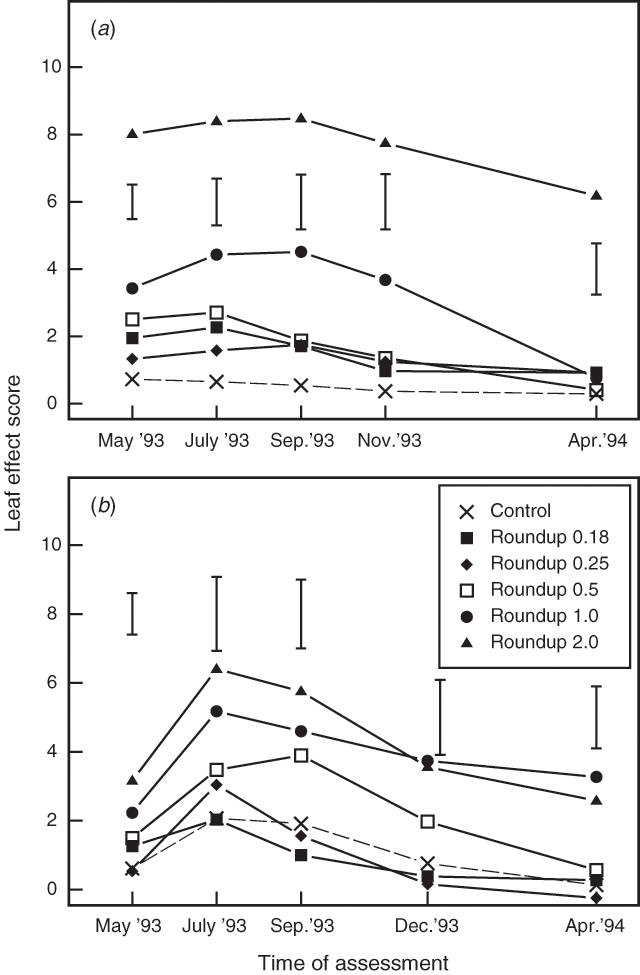
|
At both ‘Wongala’ and ‘Wallangarra’, leaf effect response patterns did not differ significantly between ‘coppice’ and ‘mature’ age classes. Because there were also no significant differences between ‘Wongala’ and ‘Wallangarra’, only coppice responses obtained at the former site are presented (Fig. 5b ). The leaf effect scores for ‘Wongala’ obtained for the highest application rate (2 kg a.e./ha), were considerably lower than those obtained for the same treatment applied to turpentine at ‘Maghera’. Nonetheless, scores for this rate were significantly higher than those for control shrubs. As at ‘Maghera’, no significant responses to adjuvants were evident at either ‘Wallangarra’ or ‘Wongala’.
‘Lochinvar’ (1993–96). No treatment effects were evident from the 1993 and 1994 samplings, except for an anomalous effect on cover in 1994 in those plots due to have Roundup applied at 2 kg/ha. The similarity of pre-treatment means in 1993 for both canopy cover and number of live stems explains why the covariate was only significant in 1 case, and even that case was probably an anomaly as already mentioned (Table 6).
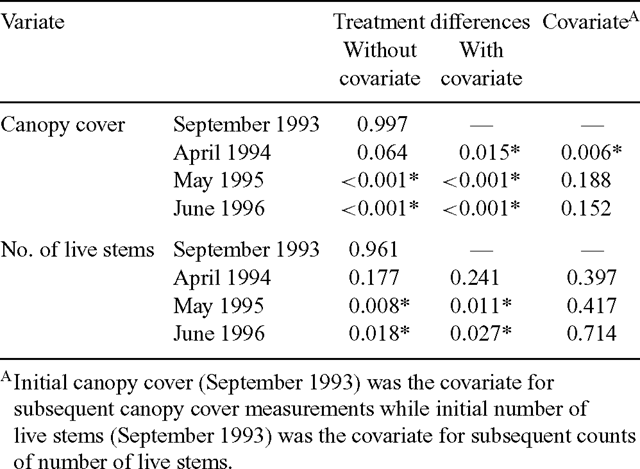
|
There was a substantial reduction in both canopy cover and number of live stems in 1995 and 1996 in those plots where Roundup had been applied and the overall treatment differences were significant in both cases (Fig. 6). There were no significant differences between the four Roundup rates, except for canopy cover in 1995, where the 1.5 kg/ha plots had a significantly higher cover than the 2.0 and 2.5 kg/ha plots.
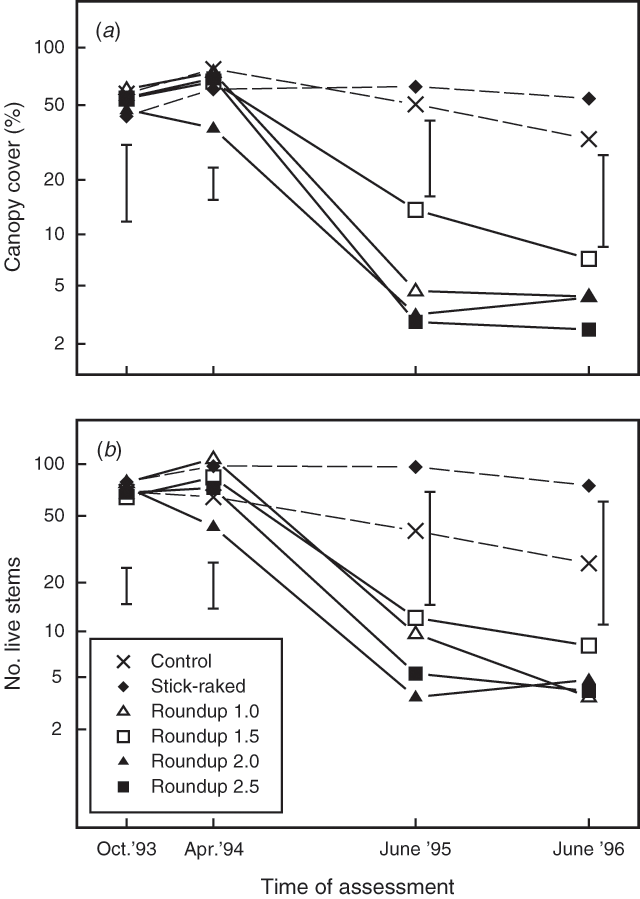
|
Aerial spraying experiments
‘Mount Oxley’ (1994–95). The generalized linear model of plant deaths (averaged across all species) obtained at the final assessment indicated that differences in response to application rate, viz. control 0.00 (±0.00), 1 kg glyphosate/ha 0.03 (±0.03), 1.5 kg/ha 0.25 (±0.06) and 2 kg/ha 0.27 (±0.05), and also volume by species interaction (Table 7), were both highly significant (P < 0.001). Leaf effect scores within a single plot also varied considerably between individual shrubs of the same species. Larger seedlings of narrow-leaved hopbush (Dodonaea viscosa ssp. angustissima) appeared to be more susceptible to Roundup than smaller seedlings. No plant size measurements were available to enable size to be included as a covariate in the statistical models.

|
In the adjacent uncleared plots, only very small numbers of mature trees and shrubs died following spraying. The most sensitive species in this regard were leopardwood (Flindersia maculosa) (two dead out of eleven tagged), supplejack (Ventilago viminalis) (2/8) and wilga (Geijera parviflora) (2/25).
‘Carpet Springs’ (1995–96). The most abundant of the major shrub species present at this site was emubush even though one third of all plots (10 out of 30) did not contain any plants of this species. Accordingly, responses for all tagged emubush plants obtained over four assessments are summarised in Table 8. Emubush was clearly susceptible to Roundup, even when applied at the lowest rate and at the lower volume, and also to Brushoff when applied alone. There was no apparent pattern in susceptibility related to rate and volume of Roundup. However, when Roundup was combined with Brushoff, the responses were significantly lower than any of the treatments using only Roundup or Brushoff, especially at the higher rate of Roundup. Emubush mortality data (i.e. those plants rated 10 at the final assessment) were also analysed using a generalized linear model with binomial errors and logit link. These results however, are not presented as they essentially replicate the leaf effect trends in assessment 4 shown in Table 8.
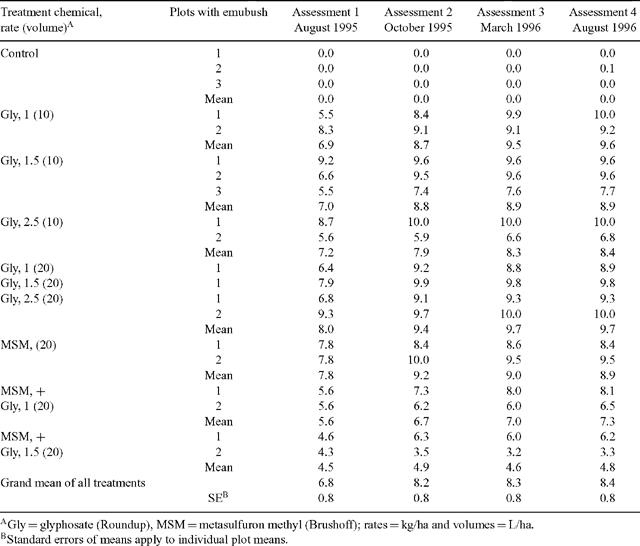
|
Variability between plots within treatments was often greater than variability between treatment means (Table 8). This suggested that spatial variability of the responses could be more important than rate and volume applied. Accordingly, the mean responses at assessment 4 are presented in plot order in Table 9 for all four species. However, there did not appear to be any overall spatial pattern. Consistent with emubush, joint application of Roundup and Brushoff resulted in scores that tended to be lower than those of adjacent plots for budda, tar bush (plot 9), and turpentine (except plots 18 and 20).
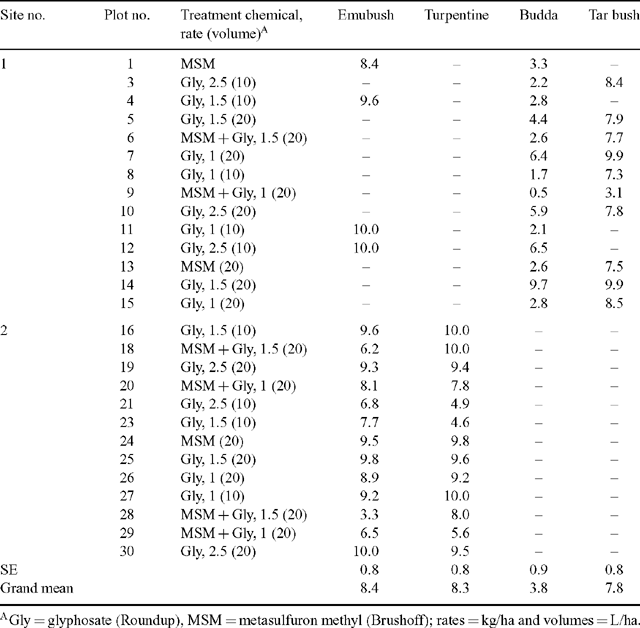
|
When leaf effect scores were averaged across all treated plots at both sites, there were marked differences between the four principal target species (Table 9). Five-year-old regeneration of both emubush and turpentine was slightly more vulnerable to Roundup and Brushoff treatment than was tar bush. However budda regeneration of the same age was significantly less vulnerable than that of the other three species.
‘Lochinvar’ (1995–96). The ANOVAs of logit-transformed leaf effect scores indicated highly significant (P < 0.001) differences between the 4 treatments at all three assessments. Means for the controls at the final assessment were significantly lower than those for all spray treatments except for the 10-year-old regrowth sprayed at the lowest application rate of 0.5 kg glyphosate per hectare. Differences between 1-year and 10-year-old stands of firebush were only significant (P < 0.05) at the lowest application rate of 0.5 kg glyphosate/ha (Fig. 7).
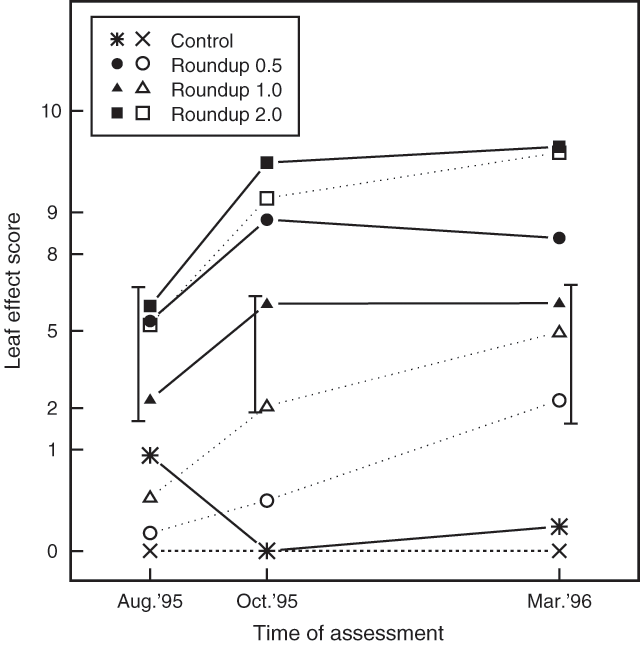
|
The enhanced susceptibility of young regrowth of firebush to low application rates of Roundup was reinforced by the analysis of mortality. The generalized linear model showed a significant (P = 0.017) age group by rate interaction, with the difference between the two age groups significant only at the lowest application rate (Table 10). The predicted mortalities presented in Table 10 are estimated mean proportions from the fitted model.

|
‘Moama’ (1996–97). As at ‘Carpet Springs’, leaf effect varied considerably between species at the final assessment (Table 11). The highest leaf effect scores were obtained for the ‘highly sensitive’ ellangowan poison bush, particularly at the higher rates of application, some response was obtained for the three ‘moderately sensitive’ species, and no response for the ‘least sensitive’ budda. There was no significant effect of shrub height for any of the species. Shrubs treated with Roundup had significantly higher scores than control shrubs for ellangowan poison bush (P = 0.026) and tar bush (P = 0.041). The apparent difference for emubush was not significant because very few plants from this species were present in the control plots. There were no significant differences in leaf effect scores between low- and medium-volume treatments for any of the shrub species targeted, and differences between application rates were only significant for ellangowan poison bush. Consequently, means for treated plants were calculated over all volumes, and over all rates except for ellangowan poison bush.
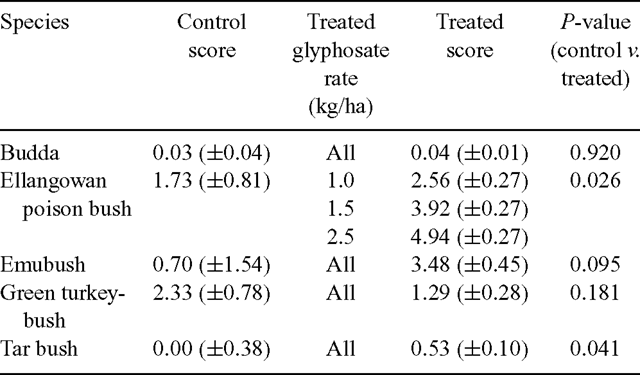
|
Leaf effect scores steadily increased over the 12 months for ellangowan poison bush (Fig. 8), with leaf effect for the two higher rates of application being significantly higher than leaf effect for control shrubs. No significant time course patterns were obtained for the other species.
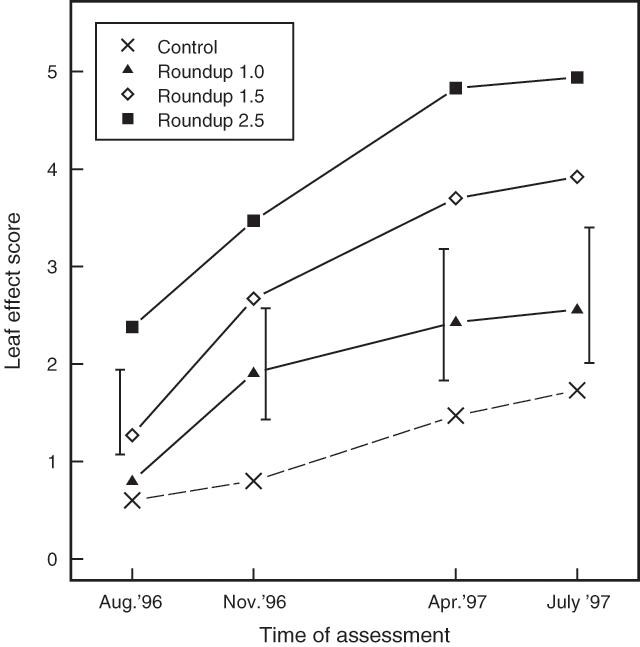
|
Economic analysis
The NPV of the 20-year cumulative net benefit stream (excluding the cost of the chemical agents) for the hypothetical 4000 ha paddock for both 1990–1991 and 2004–2005 financial values, using 5 and 10% discount rates, is presented in Table 12. The values presented in the left section of Table 12 relate to input and output price data that prevailed in 1990–91, the period during which planning for the chemical screening work described in this paper was undertaken. The values presented in the right section of Table 12 are based on contemporary financial data giving an indication of the current magnitude of net benefits that might accrue to the use of a chemical–fire treatment strategy. Also presented are the per hectare NPV values. The NPV estimate is highly sensitive to the discount rate, the appropriate choice of which is dependent on the available alternative options for investment by the owner of the paddock being examined. Discount rates in this range would be appropriate for such investments both at the time the trials commenced and at the present.

|
Using the original 1990–91 values, when the cost of chemical agent is excluded from the analysis the NPV of the cumulative stream of net benefits at discount rates of 5 and 10% are $18.47 and $8.70/ha, respectively. Therefore, the range of chemical agents that were incorporated within the field experiments described in this paper were initially screened against these threshold values (i.e. approximately $8–15) to obtain a guide to their prospective economic values under operational conditions involving larger areas of treatment than the experimental plots.
The results for the 4000 ha paddock example, incorporating contemporary price and cost data, are an NPV of $17.60 and $6.92/ha for discount rates of 5 and 10%, respectively. The decrease in these values over time, despite increased gross margin values for ewe flocks in the region (Table 2) reflects a significant increase in on-property labour and fuel costs over the period which has a major impact on stock handling and fire-breaking costs, and also the aerial delivery costs of the chemical agents. Economic application of the treatment would presently require the application volumes of any selected chemical agent to have a unit cost value below these thresholds for the appropriate discount rates.
Discussion
While earlier spot spraying experiments (Noble et al. 2001) demonstrated the existence of complex interactions involving shrub species, seedling or coppice age, plant architecture, chemical, and rate of application, some glyphosate-based treatments were found to offer considerable potential for controlling young shrub regrowth. Accordingly, it was postulated that it may be feasible to apply selected arboricides from the air over large areas of young (1–3 years old) shrub regeneration. For such a strategy to be cost-effective, however, it was also necessary to determine cost thresholds beyond which this approach became uneconomic. The economic models employed in an earlier study (Noble et al. 1993), and those presented for 1990–91 economic data in this paper (Table 12), established that treatments involving Roundup applied at rates in excess of 0.5 kg/ha were unlikely to be profitable.
At ‘Lochinvar’ where rainfall was both higher and more reliable than in the semi-arid woodlands further south, significant scorching and mortality of young firebush (Senna pleurocarpa) regeneration was achieved by applying Roundup from the air at this low rate thereby satisfying the chemical cost threshold. Cost effectiveness was further improved using an ultra-low application volume of 10 L/ha.
The tolerance or sensitivity of any target species is dependent not only on the inherent physiology of the plant but also on its characteristic architecture (Hallé and Oldeman 1975). Mature, multi-stemmed turpentine (Eremophila sturtii) regenerates as a dense coppice once it has been decapitated by fire or chaining. Many shoots emerge from subterranean meristems that are insulated from lethal fire temperatures. The proliferation of juvenile foliage maximises the target leaf area thereby enhancing the probability of sufficient spray droplets striking the canopy before absorption and translocation of the arboricide in lethal amounts.
The architecture of regenerating firebush is different, having adventitious buds located within an extensive shallow root system. This open architecture enhances the distribution and capture of spray droplets, particularly when sprayed at ultra-low volumes. The higher sensitivity of firebush to Roundup may also be related to its extremely rapid growth rate. Apart from such sensitive species, it is unlikely that ULV application of Roundup would ever be widely contemplated in other shrub-dominant rangelands due to small droplet size. While there are no comparable data available for shrubs, absorption of 14C-glyphosate applied to maize (Zea mays) was directly related to droplet size with coarse droplets showing the greatest absorption and translocation to sinks (Feng et al. 2003).
Mature plants of budda (Eremophila mitchellii) also have the capacity to coppice from a lignotuberous rootstock following fire (Beeston and Webb 1977; Hodgkinson and Beeston 1995). Mature trees of this species, however, are often more vulnerable to fire (Hodgkinson 1998). At ‘Mount Oxley’ where budda had been decapitated at ground level by bulldozing, budda coppiced relatively freely from what appeared to be adventitious buds in the surface root system (Noble et al. 2001). On ‘Bundoon Belah’ west of Cobar mature budda plants decapitated by chainsaw about 30 cm above the ground surface exhibited a marked phototropic response with epicormic shoots only emerging on the side of the trunk exposed to the sun thereby reducing canopy leaf area.
The extensive foliage scorching observed when young regrowth, for example turpentine at ‘Yarrawonga’ or budda at ‘Baykool’, was spot sprayed with dilute concentrations of Roundup could be attributed to saturation of a small canopy leaf area. These very high volumes ensured that a lethal dose of active ingredient was absorbed by each individual plant. Such species differences highlight the importance of determining the regeneration period required for each species before spraying to optimise canopy target area while the plant remains vulnerable to low rate and volume applications. Broadscale paddock application of Roundup at comparable rates and volumes from the air would obviously be uneconomic and inefficient requiring frequent landings and take-offs.
The aerial spraying experiments confirmed the existence of a comparatively narrow window during which coppicing shrubs are vulnerable to a secondary chemical treatment. Older shrubs sprayed with Roundup often exhibited clear symptoms of glyphosis manifested in smaller, often chlorotic, leaves and ultimately stunted growth. Ultimately though, affected shrubs recovered over time. In one instance, however, where a large area of 6-year-old budda regrowth had earlier been sprayed from the air with Roundup on ‘Moama’, glyphosis-affected shrubs were sufficiently weakened to enable vigorous growth by understorey grasses. This herbage response was later exploited as fuel for a prescribed fire producing, in turn, a significant reduction in shrub density (D. Haig, pers. comm.).
Only in one case was it possible to apply chemical treatments from the air to regrowth of the requisite maturity, in this case 1-year-old coppice of firebush regenerating after an initial prescribed fire. Similar experiments with older coppice of budda and turpentine induced lower leaf effect and shrub mortality. Repeated aerial spraying with Roundup at low rates could well induce a significant reduction in density of budda and turpentine although the economic benefits of such an approach would be marginal at best. Repeated aerial spraying of shinnery oak (Quercus harvardii) in western Oklahoma, USA, with 2,4-D amine applied at very low concentration (0.075 kg/ha) and low volume (9–18 L/ha) resulted in a significant reduction of its vigour and abundance (Greer et al. 1968). In this case, however, there was a decided economic advantage in that the aircraft was owned by the landholder enabling some areas to be treated as frequently as 15–20 times over a 20-year period.
In some cases a marked response to Roundup was observed with other Eremophila species such as emubush (E. longifolia) at ‘Carpet Springs’ and, to a lesser extent, tar bush (E. glabra) at ‘Moama’. Significant leaf scorching and mortality of ellangowan poison bush (Myoporum deserti) was observed following aerial application of Roundup at the latter site where these shrubs were heavily infested with the scale insect Pulvinaria dodonaea (Qin and Gullan 1992) suggesting significant synergy. This insect has also been used on a limited basis by deliberately inoculating ellangowan poison bush populations using scale-infested branches (Robinson 1996). Burrows (1973) suggested that the wingless grasshopper (Monistria pustulifera) might also be usefully integrated with other conventional treatments to control green turkey bush (Eremophila gilesii) and excessive regeneration of mulga (Acacia aneura) in western Queensland.
At this stage, the most efficient role for chemical defoliation in any integrated management program appears to be primarily as a spot spraying treatment following initial disturbance by either prescribed fire or mechanical treatment in strategically important areas, e.g. along fencelines or along roadways and laneways to facilitate livestock movement. In very dense regrowth or relatively inaccessible areas, aerial spraying of discrete infestations may be a cost-effective option, especially when used over large areas involving neighbouring properties. Such opportunities may be restricted to those relatively infrequent seasons when above-average rainfall has ensured sufficient grass fuel is available for prescribed fire (Noble et al. 1997). Aerial spraying has similar operational advantages to aerial ignition (Noble 1986) when treating large areas, especially in terms of applying treatments at an optimal time during the day.
Around 60–70% of a paddock burnt is usually recognised as an acceptable result following prescribed fire with post-fire mosaics clearly defining discrete landscape units (Daly and Hodgkinson 1996). The pilot’s ability to readily recognise and spray only those areas previously burnt, rather than spraying the entire paddock area as an initial treatment, confers major advantages in terms of application efficiency with costs per unit area significantly reduced when spread over the entire paddock area (MacLeod et al. 1993; Noble et al. 1997; MacLeod and Noble 2001).
Because rangelands are of low natural productivity and value from a pastoral production viewpoint, benefits from restoring degraded land are necessarily low per hectare (MacLeod 1993). Nonetheless, they may still be high in aggregate due to the large geographic scale of the problem. Costs of any restoration treatment based on aerial spraying obviously depend on the concentration of active ingredient to be used per treated hectare and the aggregate volume utilised. Application volume becomes a critical issue since it determines the number of return trips that the aircraft has to make for any given distance between the filling point (landing strip) and application point (target area). The fewer the flights, the cheaper and more efficient the operation per hectare. Application volume also affects logistics because of the need to use clean water that has to be carted to the airstrip in sufficient quantity. This, in turn, is influenced by the distance ex-source to the filling point on the airstrip.
Co-operative arrangements involving several paddocks and properties would reduce many costs through sharing and more efficient scheduling of operations. The use of differential global positioning system marking technology enables longer flying runs, ideally around 5–10 km (P. Smart, pers. comm.), since shorter runs with many turns increasingly require manual marking thus adding to operational costs. How and where the aircraft is obtained, and the type of aircraft, together influence costs through operational capacity, ferrying considerations and total volume of work available at the target area or nearby. Several nearby properties acting in concert would clearly reduce the cost by spreading ferrying overheads.
Acknowledgments
The studies described in this report were undertaken on properties widely dispersed throughout western New South Wales and western Queensland and without the active encouragement of the following collaborating landholders, minimal progress towards determining the potential role of chemical treatments in shrub management would have occurred: Mr Bill Bryant, ‘Baykool’, Augathella, Qld, Mr and Mrs Peter Carmichael, ‘Lochinvar’, Augathella, Qld, Mr Alan Crawford, ‘Maghera’, Bourke, NSW, Mr and Mrs Doug Haig, ‘Moama’, Eulo, Qld, Mr George Jansen, ‘Maruga’, Augathella, Qld, Mr Malcolm McGrice, ‘Wongala’, Girilambone, NSW, Mr and Mrs Herb Manns, ‘Wallangarra’, Cobar, NSW, Mr and Mrs Dave Newsham, ‘Carpet Springs’, Eulo, Qld, Messrs Ron, Lindsay and Rob Newton, ‘Mount Oxley’, Bourke, NSW, and Mr David Snelson, ‘Yarrawonga’, Cobar, NSW.
Able technical support was provided by several people during the course of these experiments but particular thanks are extended to Mr Peter Smart, Bourke Airport Services, whose piloting skills and wide knowledge of pesticide application were critical to the successful establishment of all the aerial spraying experiments. The capable technical assistance provided by Ian Curtis, John McMaster, Gil Pfitzner and Allan Reid (all then CSIRO Wildlife and Ecology, Canberra) and Wil Muller (QDPI, Charleville) during the course of these studies, is gratefully acknowledged. Lois Smart, Alistair Noble and John Barber provided valuable assistance as markers during establishment of the aerial spraying experiments. Tony Grice initially assisted in the selection of the ground-spraying sites at ‘Maghera’, ‘Wallangarra’ and ‘Wongala’ and together with Melissa Dobbie, Ken Hodgkinson, Wal Whalley and two anonymous referees, provided valuable comments on previous drafts of this manuscript. This research was funded by the Australian Wool Research and Development Corporation (Projects CLL 19 and DAQ 85) while chemicals used in the aerial spraying experiments were provided by Monsanto Australia. This combined support is gratefully acknowledged.
Andrew M. H.,
Noble I. R., Lange R. T.
(1979) A non-destructive method for estimating the weight of forage on shrubs. Australian Rangeland Journal 1, 225–231.

Batianoff G. N., Burrows W. H.
(1973) Studies in the dynamics and control of woody weeds in semi-arid Queensland. 2. Cassia nemophila and C. artemisioides.
Queensland Journal of Agricultural and Animal Sciences 30, 65–71.

Beeston, G. R. ,
and
Webb, A. A. (1977).
Booth C. A.,
King G. W., Sánchez-Bayo F.
(1996a) Establishment of woody weeds in western New South Wales. 1. Seedling emergence and phenology. The Rangeland Journal 18, 58–79.

Booth C. A.,
Sánchez-Bayo F., King G. W.
(1996b) Establishment of woody weeds in western New South Wales. 2. Growth and competitive potential. The Rangeland Journal 18, 80–98.

Burgess D. M. D.
(1988) The economics of prescribed burning for shrub control in the semi-arid woodlands of north-western New South Wales. Australian Rangeland Journal 10, 48–59.

Burgess, D. M. D. ,
and
Murphy, J. (1989).
Burrows W. H.
(1973) Studies in the dynamics and control of woody weeds in semi-arid Queensland. 1. Eremophila gilesii.
Queensland Journal of Agricultural and Animal Sciences 30, 57–64.

Cunningham, G. M. ,
Mulham, W. E. ,
Milthorpe, P. L. ,
and
Leigh, J. H. (1992).
Daly R. L., Hodgkinson K. C.
(1996) Relationships between grass, shrub and tree cover on four landforms of semi-arid eastern Australia, and prospects for change by burning. The Rangeland Journal 18, 104–117.

Dobson, A. J. (1990).
Feng P. C. C.,
Chiu T.,
Sammons R. D., Ryerse J. S.
(2003) Droplet size affects glyphosate retention, absorption, and translocation in corn. Weed Science 51, 443–448.

Gifford R. M., Howden S. M.
(2001) Vegetation thickening in an ecological perspective: significance to national greenhouse gas inventories. Environmental Science Policies 4, 59–72.
| Crossref | GoogleScholarGoogle Scholar |

Greer, H. A. L. ,
McIlvain, E. H. ,
and
Armstrong, C. G. (1968).
Hallé, F. ,
and
Oldeman, R. A. A. (1975).
Harrington G. N.
(1979) Estimation of above-ground biomass of trees and shrubs in a semi-arid Eucalyptus populnea woodland using regression of mass on trunk diameter and plant height. Australian Journal of Botany 27, 135–143.

Harrington G. N.,
Oxley R. O., Tongway D. J.
(1979) The effects of European settlement and domestic livestock on biological systems in poplar box (Eucalyptus populnea) lands. Australian Rangeland Journal 1, 271–279.

Hodgkinson K. C.
(1979) The shrubs of poplar box (Eucalyptus populnea) lands and their biology. Australian Rangeland Journal 1, 280–293.

Hodgkinson K. C.
(1993) Prescribed fire for shrub control in sheep rangelands.
: ‘Pests of pastures: weed, invertebrate and disease pests of Australian sheep pastures’. (Ed. E. S. Delfosse)
pp. 219–225. (CSIRO Information Services: Melbourne.)
Hodgkinson K. C.
(1998) Sprouting success of shrubs after fire: height-dependent relationships for different strategies. Oecologia 115, 64–72.
| Crossref | GoogleScholarGoogle Scholar |

Hodgkinson K. C., Beeston G. R.
(1995)
Eremophila mitchellii Benth.
: ‘The biology of Australian weeds’. (Eds R. H. Groves, R. C. H. Shepherd, R. G. Richardson)
pp. 123–135. (R.G. and F.J. Richardson: Melbourne.)
Hodgkinson K. C., Harrington G. N.
(1985) The case for prescribed burning to control shrubs in eastern semi-arid woodlands. Australian Rangeland Journal 7, 64–74.

Johnson R. W., Back P. V.
(1977a) Relationship between burning and spraying in the control of brigalow (Acacia harpophylla) regrowth. I. Burning as a pre-spraying treatment. Queensland Journal of Agricultural and Animal Sciences 34, 179–187.

Johnson R. W., Back P. V.
(1977b) Relationship between burning and spraying in the control of brigalow (Acacia harpophylla) regrowth. II. Burning as a post-spraying treatment. Queensland Journal of Agricultural and Animal Sciences 34, 189–196.

MacLeod N. D.
(1993) Economic cost of shrub encroachment in western New South Wales.
: ‘Pests of pastures: weed, invertebrate and disease pests of Australian sheep pastures’. (Ed. E. S. Delfosse)
pp. 58–63. (CSIRO Information Services: Melbourne.)
MacLeod N. D., Johnston B. J.
(1990) An economic framework for the evaluation of rangeland restoration projects. Australian Rangeland Journal 12, 40–53.

MacLeod N. D., Noble J. C.
(2001) Economic and ecological aspects of rehabilitating degraded rangelands within an integrated framework.
: ‘Land degradation’. (Ed. A. Conacher)
pp. 291–303. (Kluwer Academic Publishers: Dordrecht.)
MacLeod N. D., Brown J. R., Noble J. C.
(1993) Ecological and economic considerations for the management of shrub encroachment in Australian rangelands.
: ‘Proceedings of the 10th Australian and 14th Asian-Pacific Weed Conference, Brisbane II’. (Weed Society of Queensland: Brisbane.)
Mathews, G. A. (1979).
Murphy, R. (1989). Economics of some pasture restoration options.
: ‘Australian Rangeland Society/Southern Maranoa Pastoralists Association, Workshop’. Bollon, 25 May, 1989
Noble J. C.
(1986) Prescribed fire in mallee rangelands and the potential role of aerial ignition. Australian Rangeland Journal 8, 118–130.

Noble, J. C. (1997).
Noble J. C.
(2001) Lignotubers and meristem dependence in mallee (Eucalyptus spp.) coppicing after fire. Australian Journal of Botany 49, 31–41.
| Crossref | GoogleScholarGoogle Scholar |

Noble J. C., Walker P.
(2005) Integrated shrub management in semi-arid woodlands of eastern Australia: a systems-based decision support model. Agricultural Systems In press ,

Noble J. C.,
Grice A. C.,
Dobbie M. J.,
Müller W. J., Wood J. T.
(2001) Integrated shrub management in semi-arid woodlands of eastern Australia: effects of chemical defoliants applied after an initial disturbance. The Rangeland Journal 23, 224–258.

Noble J. C., Harrington G. N., Hodgkinson K. C.
(1986) The ecological significance of irregular fire in Australian rangelands.
: ‘Rangelands: a resource under siege. Proceedings of the 2nd International Rangeland Congress, Adelaide’. (Eds P. J. Joss, P. W. Lynch, O. B. Williams)
pp. 577–580. (Australian Academy of Science: Canberra.)
Noble J., MacLeod N., Griffin G.
(1997) The rehabilitation of landscape function in rangelands.
: ‘Landscape ecology, function and management: principles from Australia’s rangelands’. (Eds J. Ludwig, D. Tongway, D. Freudenberger, J. Noble, K. Hodgkinson)
pp. 107–120. (CSIRO Publishing: Melbourne.)
Noble J. C., MacLeod N. D., Ludwig J. A., Grice A. C.
(1993) An evaluation of the potential benefits of integrated shrub control strategies for Australian semi-arid rangelands.
‘Proceedings of IVth International Rangelands Congress’. Montpellier, France. 22–26 April, 1991 (Ed. A. Gaston ,
M. Kernick ,
H. Le Houérou )
pp. 846–849. (Service Central d’Information Scientifique et Technique: Montpellier.)
Patterson H. D., Thompson R.
(1971) Recovery of inter-block information when block sizes are unequal. Biometrika 58, 545–554.

Qin T. K., Gullan P. J.
(1992) A revision of the Australian pulvinariine soft scales (Insecta: Hemiptera: Coccidae). Journal of Natural History 26, 103–164.

Robinson N.
(1996) Landholders at the front-line of weed research. Australian Geographic (January–March), 30–31.

Schall R.
(1991) Estimation in generalized linear models with random effects. Biometrika 78, 719–727.

Scifres C. J.
(1986) Integrated management systems for improvement of rangeland.
: ‘No-tillage and surface tillage agriculture’. (Eds M. A. Sprague, G. B. Triplett,
)
pp. 227–259. (John Wiley and Sons: New York.)
Scifres C. J.
(1987) Decision analysis approach to brush management planning: ramifications for integrated range resources management. Journal of Range Management 40, 482–491.

Scifres, C. J. ,
Hamilton, W. T. ,
Conner, J. R. ,
Ingliss, J. M. ,
Rasmussen, G. A. ,
Smith, R. P. ,
Stuth, J. W. ,
and
Welch, T. G. (1985).
Scifres, C. J. ,
Mutz, J. L. ,
Rasmussen, G. A. ,
and
Smith, R. P. (1983).
Walker J., Gillison A. N.
(1981) Australian savannas.
: ‘Ecology of tropical savannas’. (Eds B. J. Huntley, B. H. Walker)
pp. 5–24. (Ecological Studies, Vol. 42. Springer-Verlag: Berlin.)
1Botanical nomenclature according to Cunningham et al. (1992).
2To avoid unnecessary repetition, this species will hereafter be referred to simply as ‘budda’.


